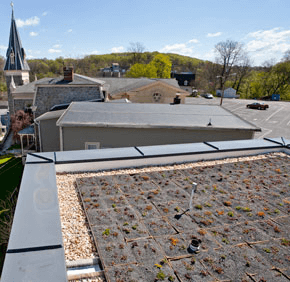By Elizabeth Skalski
Stella Maris has swapped Styrofoam products for biodegradable silverware and plates made from corn starch and sugarcane, and uses washable and reusable lids for mugs and soup bowls.
“The downside to any of this,” said Cheryl Mohn, Stella Maris’ director of dining services, “is that green costs a lot of ‘green.’ It’s a financial commitment.”
Several other institutions in the archdiocese, new and old, are also committed to energy efficiency year-round, not just on April 22, Earth Days.
Archbishop Spalding High School has four rain barrels, automatic turn-off lights and faucets, low-flush toilets and single stream recycling, among other things, said Kathleen Mahar, president of the Severn school.
“It really was initiated by students and teachers,” Mahar said. “That’s what was most exciting.”
This summer the school is installing energy-efficient lights in the parking lot – another step “to be here 50 years from now and not leave such a tremendous carbon footprint,” Mahar said.
Nolan McCoy, director of facilities and real estate for the Archdiocese of Baltimore, said more parishes and schools need to get in touch with their “green” side.
At the “bare minimum,” McCoy urges parish and school leaders to spend one hour online completing a free energy audit to measure their energy performance. Only about a dozen parishes in the archdiocese have done so thus far, McCoy said.
“It’s an ongoing process of education and awareness,” McCoy said. “The cost of energy is going to be increasing and we have to be very thoughtful in how we run and operate our buildings.”
New regulations and tax credits help to drive the replacement of traditional appliances with their energy-efficient counterparts.
“It’s a way of looking at the big picture,” said Matthew Regan, the archdiocese’s project manager for the division of facilities and real estate.
Being “green” is “more basic” than an energy audit, Regan said. Pastors “have to believe in it and they have to realize it is a mission the parish should be looking at.”
St. Ignatius Loyola Academy in Mount Vernon, is renovating a vacant school building at Holy Cross, Federal Hill, in preparation for its July 2013 move.
“It’s important for us, as an education institution,” said John Ciccone, president of St. Ignatius Loyola Academy,” that we are doing what we have the ability and the resources to do for the environment and in a way that is going to be more sustainable.”
The new building’s green features include a new roof designed to reduce heating and cooling costs, low-flush toilets and a heating and air conditioning unit with optimum energy performance, among other elements, Ciccone said.
“Our new materials are going to have a recycled content percentage,” Ciccone said, “and they’re going to be regional materials (which leaves) less of a carbon footprint.”
In March, St. Paul, Ellicott City, opened a new building, complete with a green roof, said Father Matt Buening, pastor.
“This isn’t just something (parishes and schools) should do because it makes you feel good,” Father Buening said. “They should do it because it’s a smart thing to do. It has practical benefits.”
The parish also uses compact florescent light bulbs and collects and recycles cell phones and toner cartridges, Father Buening said.
“Every parish is meant to be a teacher,” Father Buening said. “They can bring it to their workplace, they can bring it to their schools and it multiplies.”


